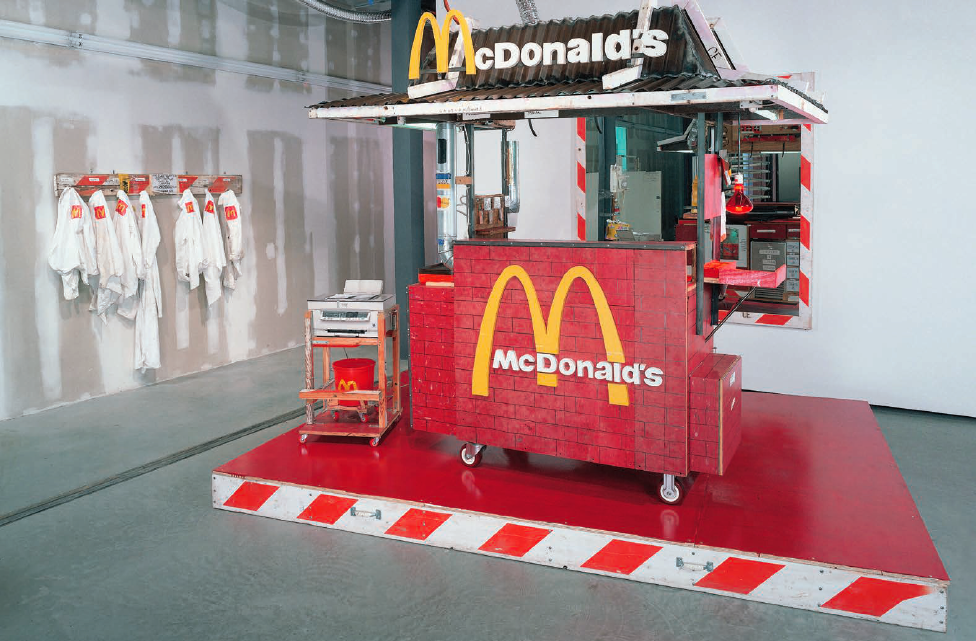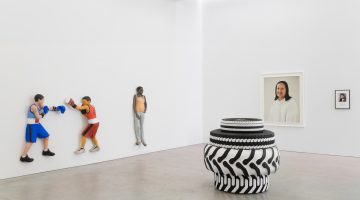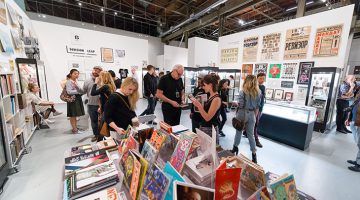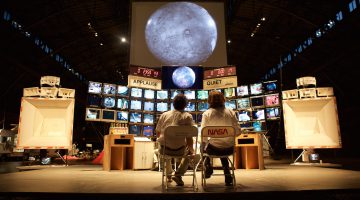Tom Sachs is an American artist, based in New York City, with a talent for putting unlikely things together with a deep antipathy to verisimilitude. Everything he makes—from his fully-functional Chanel Guillotine (Breakfast Nook) of 1998 and the 103 working cannons on his Barbie Slave Ship (commissioned 2013) to a full line of easy-care IKEA particle board and carbon fiber tape Judd chairs (launched 2009 and ongoing)—is or does something real. For two decades, Sachs and his merry band of bricolympians have synthesized their complementary obsessions with modern sculpture and consumer-age-materialist-tweaker subcultures (e.g. model car racing, Hello Kitty, luxury goods, Star Wars, the military-industrial complex, international modernism, and, small arms manufacture) in assembled worlds brought to life through actual use.
Remember what it was like to be nine, when you lived whatever alternate reality you and your friends were into? I played Dungeons and Dragons in 12-hour stretches with Roger Crist and audiophiled it up with my dad, comparing versions of Sibelius’s Symphony No. 2 on a tricked-out hi-fi with a Heathkit preamp he let me help him build. My younger brother was into ninja paraphernalia, Taco Bell, and drawing cartoons. That’s how Sachs, his studio, and the constellation of inspired lunatics who orbit around each of his projects conduct their business—like a band of nine-year-olds with laissez-faire parents and access to one kid’s dad’s well-appointed garage workshop in the summer after fourth grade. Begging the question, “What is the only full-size, free-standing, Apollo-era lunar lander in the world other than NASA’s—namely Sachs’s—doing if it is not being used to explore space?” Bullshit. Tom’s lunar module has been to the moon (Los Angeles, 2007) and Mars (New York, 2013). This summer—gods and the suspension of disbelief willing—it will touch down on the ultra flat frozen surface of Jupiter’s ice moon Europa. Tom Sachs Space Program: Europa is the second stop on a tour that began earlier this year as Tom Sachs: Tea Ceremony at The Noguchi Museum and will conclude at the Nasher Sculpture Center in Dallas in the summer of 2017, returning to that compact, tea-focused configuration. (The arc of the tour roughly reflects that of three overall missions: first, research, development, and space camp at the Noguchi, then the voyage to Europa at the Yerba Buena Center for the Arts, and finally the return to Earth, decompression, and debrief at the Nasher.)
Among the many subcultures to which Tom has devoted himself, none is more reflective of his ambition than his version of NASA, which runs in parallel with the US government’s, itself one of the greatest craft projects in the history of man, albeit on a slightly larger budget. Exploring the universe leads to a lot of thinking about humanity in the abstract. Tom’s response has been to investigate the different ways in which we represent who we are—just as NASA did with the Voyager Golden Record—as well as strategies for managing the many difficulties associated with sending fellow humans off-world. Research is ongoing—pot is still, obviously, in the running—but Tom has concluded, at least for now, that the two things we should take to the Moon or Mars or Europa when we’re ready to colonize are hip hop and tea ceremonies. Those also happen, not coincidentally, to be excellent tools for staying in tip-top mental shape if you’re making the journey and expected to function at a consistently high level, with great ingenuity and flexibility, under less than optimal conditions.
In the following conversation, Tom and I address (obliquely) why Sen no Rikyū (1522-91), the godfather of Japanese tea ceremony and one of history’s earliest recorded artist martyrs, and Alan Shepard (1923-98), only the fifth man to step on the moon but the first to play golf there, would undoubtedly have been friends or lovers had time not conspired to keep them apart. For a somewhat more focused and cogent account of the natural sympathy between humanity’s search for self in outer space and within the confines of the tea house, see Tom Sachs’ Tea Ceremony Manual (The Noguchi Museum, 2016).
We’re sitting in your studio, not at the Noguchi Museum where Tom Sachs: Tea Ceremony is on view through July 24. There is nowhere quiet at the museum to have a conversation right now, so this makes more sense. It’s also good, because we want to talk about your history, not just what’s going on at the museum.
It makes me think, over the course of the 11 years we’ve known each other—what blows me away is how much your studio transforms, based on whatever you’re working on. This space has been so many different things. It’s been a mission control center; right now you’re building a café; it was a bodega just a few months ago; it’s been a shrine for James Brown. It’s always kind of an Italian renaissance studio for craft traditions of every conceivable sort—woodworking, metalworking, ceramics, painting, and sculpture, obviously. It’s like Verrocchio’s studio. Or Donatello’s, even better, where you do it all, can make anything, whatever a patron or client needs.
The model that I think of when I think about the studio is Eames’s studio. When I read interviews about what it was like, they said in a week it could be three totally different things. They’d move all the tables, stack them all up against the wall and build a set, and then they’d come back the next day and it’s like an office.
But it’s like Eames with schizophrenia, or Eames on crack—without boundaries. I mean, they were amazing and inventive, and you know, extraordinarily open-minded, and it’s still neat to look back at what they did, but you’ve added 10 other modalities.
Well, we do a lot of stuff here. Making a movie is incredibly elaborate. Doing a tea ceremony is equally elaborate in a different direction—making sculpture, having all this equipment to do different material. That’s why I’ve avoided ceramics for so long, because of the dust. I hate it.
Is it worse than sawdust?
Yeah, I think plaster is the worst, and ceramic dust, because it’s so fine, it just gets everywhere. When I was in college I didn’t do ceramics—I did metal because all the ceramicists were covered in white dust and it wasn’t sexy, whereas metal workers always had black dust and it just looked tougher. That’s how I got into metal. Sex appeal. It just looks cooler.
Okay, so just a very open-ended question about the language you use in your work—what’s a nugget?
A nugget is a gold nugget. It’s the idea of traveling to the West Coast and going into the wilderness and finding something in nature, in the abyss of nature . . . the idea of the nugget, or the McGuffin, the unknown, the magical object of high density and value is the metaphor. But then when I think about what it has to do with sculpture; there are certain sculptures that have a high density. I’m not talking about a sprawling Richard Serra, but I imagine a sculpture of Max Ernst’s, where it’s small and dense.
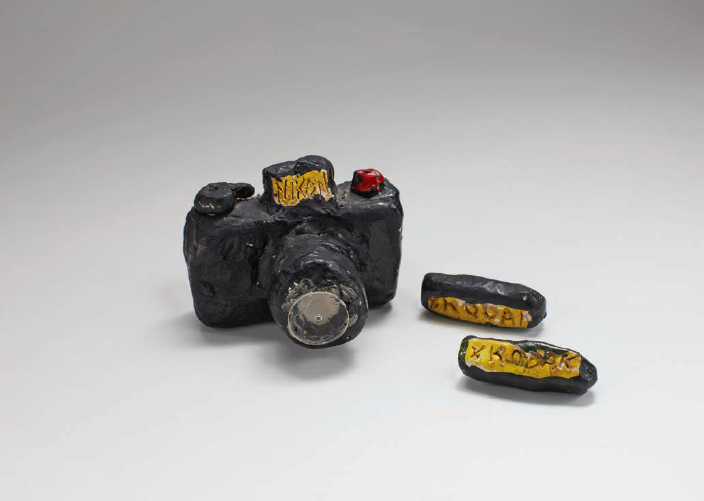
Untitled (Nikon), 1974. Clay and paint, 3 x 2.5 x 2 inches. Courtesy of the artist.
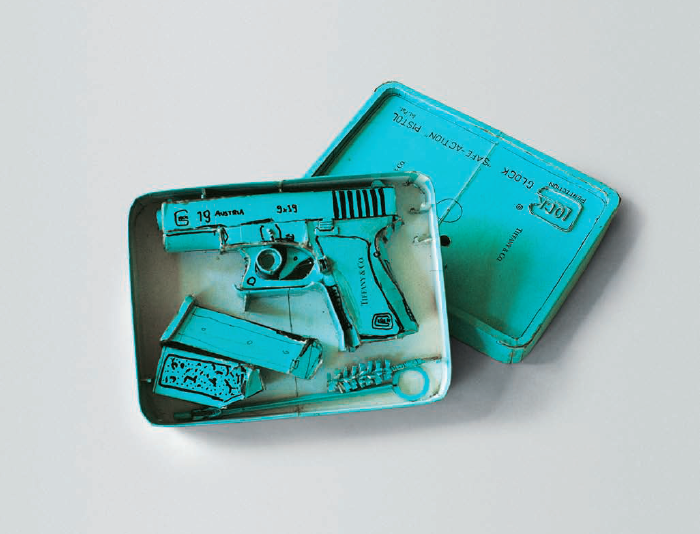
Tiffany Glock (Model 19), 1995. Cardboard, thermal adhesive, and ink, 2.5 x 6.5 x 9 inches. Courtesy of the artist.
But it doesn’t imply anything about what formal tradition it is or isn’t in. I think that’s part of what I respond to in your work: you have a capacious definition of what constitutes magical, in terms of what can be a nugget. It’s not within a limited frame. You said Max Ernst, I think more of Jean Arp if you’re thinking in abstract terms, but that is a very narrow-minded way to look at it.
Arp is a better sculptor. Max Ernst isn’t known for his sculpture.
Ernst is a better storyteller, but he doesn’t make things that are as formally compelling.
Yep, without a doubt, but I think the over-arching thing, whether it’s a spaceship or a Judd , is that the object itself, regardless of what the story is, has formal considerations that use high density as a priority. So, not flailing arms, but a torso fragment. Not a figure, but a head. Certainly Brâncuși’s sculptures are nuggets, but maybe less Bird in Space and more so Flying Turtle (Turtle) or The Kiss.
A wooden cup. Those are the Brâncușis I want. Any of those ones that don’t sit up straight.
That contain nothing.
Right. Just wood.
Solid. That’s the ultimate.
With a little handle—I don’t even know what you call it, it’s barely a handle.
It’s a gesture of a handle, yeah, the wooden cup. But of course with the wooden cup, it doesn’t work without the Brâncuși base. That’s a huge part of it because it’s the presentation. And I don’t even remember which bases he used for that cup.
I’m picturing it in the middle of your marble table right now. It looks pretty good.
Yeah, I think that’s true, but this table is a particularly great sculpture pedestal. Everything looks good on this, even more so on the small coffee tables I think. Even Bose speakers. It came with a tulip base, it was the same kind of thing.
It’s very Atomic Era.
And those were beautiful—when speakers were things that were things to be seen first and then heard, that kind of was the apotheosis. Now of course speakers are invisible.
The only question event planners want to know is how thin are the speakers, how discreet.
They’re hideous. They should be heard and not seen. It’s sound. I agree with that.
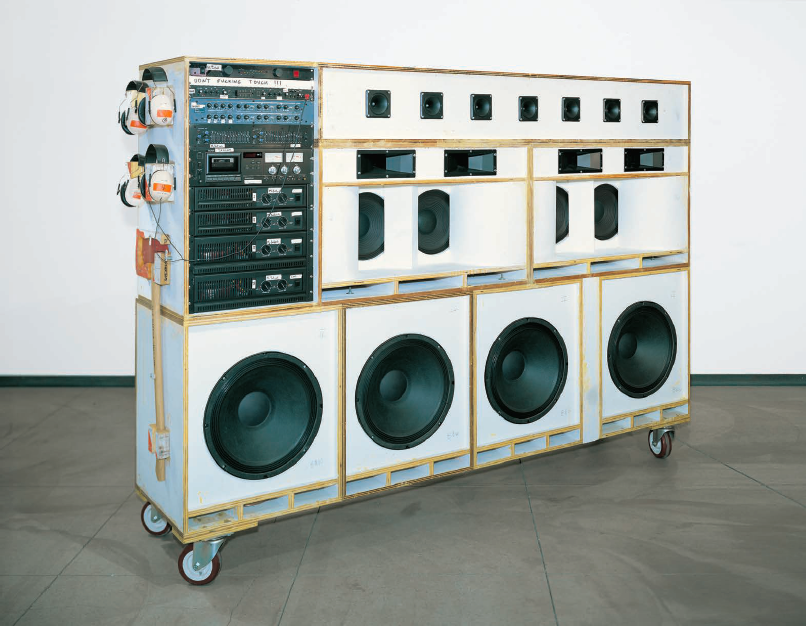
Toyan’s Jr., 2001. Mixed media, 73.625 x 103 x 23.375 inches. Courtesy of the artist.
But you don’t agree with it at all because you love engineering made visible, and that is what’s so wonderful about speakers, and this whole tradition of designing speakers to be viewed without their screens, is that the speaker functions better without its screen. That was a debate at my house, whether my dad had to leave the screens on the Infinity tower speakers or not. My dad argued that a) they sound better (that’s all that really matters), and b) it’s great to see the cones going.
Men buy with their eyes. Yeah, it’s storytelling. I think that’s one of the things that is very important in all of what we do here is that you see the evidence. That’s why you paint the wood before you cut it, because you see that it was cut.
One thing that occurs to me is that there’s not just one way—there’s not one answer to how to work. You said in carpentry there’s no going backwards. You’ve turned that into a defining trait of what you do. Everything you make—your entire approach to making things—is all about forward motion. Where do you go from here? “Okay, so now I fucked that thing up, I broke it, I sawed too far, the hole is too big, the screw stripped out,” whatever it is, it’s, “Okay, now what do I make it into?”
Wood is only a reductive material, but someone reading this would say, “Oh but you know, you can always use glue or screws,” and of course, and that’s what I do. But, a wood carver would say that’s not carpentry, it’s composite work or something, and so there’s the adage: a good carpenter is someone who can fix his mistakes quickly. Grinder and paint makes me the welder that I ain’t! Or it looks good for my house. But I think, for me, as a self-taught worker in all these mixed media, it’s those fuck-ups that make the thing sing because the iPhone is flawless in every-way it’s the most, best, perfectly made thing and there’s zero evidence—and continuing zero working evidence—to show that human beings were involved with making it.
I’m fascinated by the hermeticism of the iPhone, the idea that there’s no way into it.
Right, and having taken one apart after watching extensive YouTube videos on how to take one apart and put it back together—and I am extremely handy—I will never, ever take one apart and successfully get it back together again. It is just beyond my patience. Showing the flaws is what gives Sachs character or Dakin character—the things that you make, the beautiful handmade “please don’t do cocaine in the bathroom” sign, which I still need to hang in the bathroom. Cocaine is disgusting; it’s awful. Amphetamines are way superior in every possible way, but I don’t have any drug hang-ups.
Are amphetamines totally synthetic?
As far as I know. I don’t know how it’s manufactured.
Cocaine is natural, right?
Yeah. But I don’t know if I’m getting . . . in New York City, if I’m getting the pure un-diluted stuff. I’ve had what people say is “good coke,” but to me it’s not nearly as good as the Adderall they prescribe to children so that they can get into Brown.
Have you ever thought about doing a bricolage drug? How would you go about constructing a drug?
Well, before I answer that I would just say that my interest in drug culture, going back to high school, has always been about the paraphernalia and how you bricolage the ingestion of the drugs. I’ve made so many bongs, but I’ve never really liked smoking weed. They were these illicit objects, you know, the criminality of it was sexy, the rituals were interesting. I remember my best friend was not asked back to my prep school, and I remember I gave her this bong as a going-away present because she was going to boarding school, where you have to have a really good bong, and years later, decades, people would come up to me and say, “Oh you’re Tom Sachs? You made Scarface.” And I was like, “What’s Scarface?” And people would say that was the name of Alex’s bong. And I was like, “What was it?” And they described it, and I had totally forgotten I had taken all these little soldier parts and made a really horrible gory battle scene where I like pushed tank treads into people’s bodies. It was probably like a really shitty—a 15-year-old boy’s version of that amazing Chapman Brothers scene with all the zombies and Nazis—the best sculpture of all time.
That’s what I was picturing. But it predated the Chapman Brothers. They may have seen it!
Maybe if they went to that boarding school!
If you were going to build a drug, how would bricolage apply to drug-making? We’re identifying two really different paradigms of how to make drugs.
Isn’t that what cooking and hospitality and the tea ceremony is really all about?
I was working my way there, damn it!
I didn’t know, I didn’t know! Sorry but no, they’re not unrelated.
I mean, the broad question is like, what links together all of these cultures that you’re interested in, and that you draw on? And you just said one thing, which you say all the time, that the only reason you do this is to make cool shit in a long, well-developed tradition of things, but it’s not just that. What gets you from bongs to tea? That seems more kind of obvious because of the ritualistic quality and the communal nature and all of that. But what gets you from Star Wars to tea? Or, Satanism to tea?
People are into tea for four reasons, roughly three general food groups of reasons. Number one, spirituality, religion. My aunt is in the religion industry. And I told her that I was exploring Zen and was so happy that I had finally found a religion that I felt like I could deal with. She said, “Sorry to disappoint you, Thomas, but Zen is not a religion, it’s a philosophy.” But I was close enough. It’s faith. Fuck people who spend all their time making stupid distinctions between big huge important things. Is it art or design? I don’t know. I don’t care!

Tea House, 2011-2016. Mixed media, 122.5 x 132 x 202.75 inches. Courtesy of the artist.

Icebucket, 2015. Plywood, synthetic polymer paint, epoxy, aluminum, steel hardware, and Con Edison barrier wood, 7 x 8.125 x 9.875 inches. Courtesy of the artist.
Yeah, it doesn’t matter. The same kinds of decisions are made. Same usefulness, the same function in your life.
Number two is sensuality. Drugs. Taste. Texture. Food. How things interact with your body. How many of the senses can you tickle? Sound, all that. And then the third main category is architecture. The tea house that surrounds us, the garden, the kimono, the tea bowl, the hardware, the tea scoop, the whisk, all the ways of conveying water from the bottom of the well mixed with tea that grows from the trees that’s then processed into matcha. Fire, which starts with wood that’s grown from a tree, that’s made into charcoal, that’s cultivated to organize and control flame, so that altogether the tea ceremony is nothing but the act of preparing and serving a bowl of tea. All these three things come together. The ritual and the architecture come together to create the sensuality of the experience. So for me, my focus has been clearly on the architecture, the design, the sculpture of the accoutrements, the hardware. I’m not James Bond, I’m more Q, the guy who makes the weapons and the cars and stuff for James Bond to fight with. That’s also how the tea ceremony links to other activities in the studio, like the space program or the action of making sculpture. Architecture connects the tea ceremony with the sculpture that I’ve been doing in the studio for the past 30 years.
My love is for the thing, but without context the thing means nothing. When I think about something incredible like a Giacometti or a Brâncuși or something, those things kind of can exist almost without context.
They were made to be able to survive any context.
Yeah, and they do. You can see one buried in a garden, you could see one in the oppressive exaltation of the Museum of Modern Art.
Or some shitty corporate lobby, or who knows where.
And they were, and they are still in a goddamn lobby. Although, I think some of those places are probably stressed about the value of them and have to deaccession them from that context because lobbies are too shitty. And I think that, to be honest, that’s where my ambitions have always laid, in those perfect realms; that’s sort of how I started. But the utility starts to communicate rituals. But at the core and with posterity the context again is stripped and the object is rendered pure by history. It’s more interesting when things rely on context. I think I was trying in the beginning to make things that could be context-proof.
A perfect, autonomous, discrete, indestructible, aesthetic statement.
And I think a true nugget does that. I think a Cycladic figure does that, but then again, it needs to be on a base in a glass box because it’s so precious. Or Picasso’s skull (the bronze skull) has that ability. There’s a great article by Harold Rosenberg, where he talks about how the Nazis went through France and took all those bronze sculptures and melted them down to make ammunition and they went through a foundry and collected all the bronze, but when they saw this Picasso bronze skull they were afraid of it, or liked it, so they left it.
Totally apocryphal. But it is true that Picasso had a lot of people help him out—because . . . he kept casting in bronze even after the Nazis had made it illegal to cast anything other than weapons. They basically turned this entire industry over to hell-wreaking, but Picasso wanted to get a lot of his plaster casts because he was worried what was going to happen through the run of the war. And actually it was the fault of French soldiers, not German soldiers, because he was at his place in Boisgeloup and the French moved in to use it as a headquarters for the army, and they tossed a bunch of his plaster sculptures out the window, and broke them. Not good. He loved those things; so moved what he could to Paris and then went about casting them in bronze in secret, even though it was already illegal.
So they would be more durable.
So they’d survive.
Right, because they’re just as beautiful in bronze as they are in plaster, but in bronze you could probably toss it out a second story window, and you could still get your money at Sotheby’s.
Absolutely. He didn’t care about what they were worth, but he wanted them to survive. He loved the idea that these things that he made would be found a thousand years from now. How much do you think about the survival of your nuggets? Because so many of your nuggets are—just by the nature of working as a bricoleur—so many of your objects are made up of things with different degrees of survivability.
Inherent vice, even.
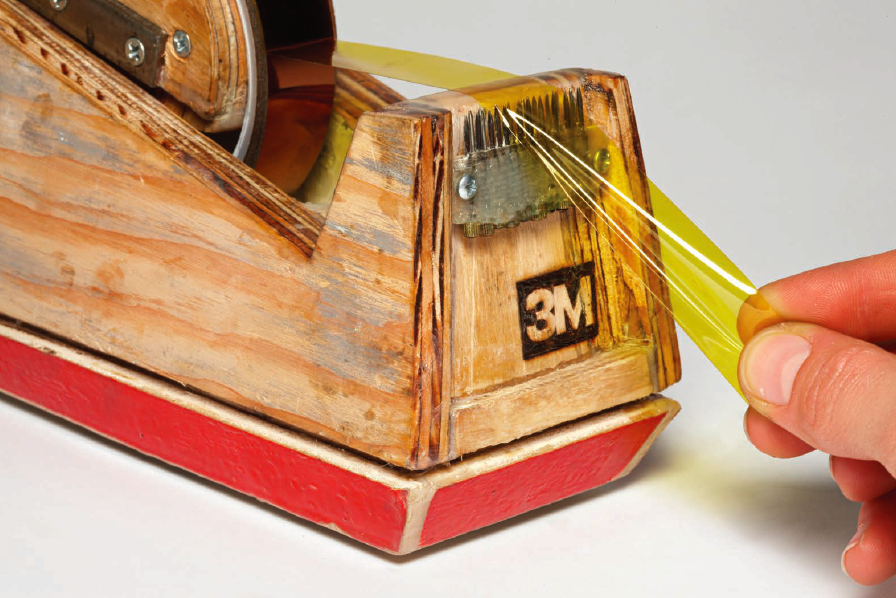
Tape Dispenser, 2012. Mixed media, 4.75 x 9.25 x 3.25 inches. Courtesy of the artist.
So much. You could make an argument that all of your work is about inherent vice.
As the years pass I’ve become more conservative. There’s an 18-foot long, 7-foot high, 3-foot wide foamcore model of Le Corbusier’s Unité d’habitation in Marseille in the Guggenheim’s permanent collection. I remember when the acquisition was made, I was not totally happy with the terms of it, but now that it’s not my problem. I feel like I made the best deal in the universe.
You mean it wasn’t enough money, but now you know that that thing is going to be preserved forever?
I just know that it’s not my problem anymore. Or maybe it is my problem, but I’ve got partners in my problem.
But it is still kind of your problem, because we have a small piece of it that you kept in the exhibition at The Noguchi Museum.
Yeah, we have a fragment from of it. It’s made of paper . . . a sandwich of paper on the outside and rotting Styrofoam on the inside, so it’s literally got leukemia.
The great thing though about foamcore is that it’s so light. One misconception that many people have about sculpture—Noguchi working in stone—is that it’s really durable. But the reality is that the heavier something is the more danger it is to itself.
Because it can crack?
Well yeah, if you move them. The equipment to move a piece of stone is, at the end of the day, stronger than the stone. So it can do a lot of damage to it, and so can gravity. Whereas something as light as your Unité building, that structure, yeah, little things will ding and dent and—
Water. Moisture.
Water’s bad for sure. That’s tough. It’s like a sponge. But so is stone, by the way. Our stones sweat out the water that they’ve accumulated through the winter every spring.
And that can also cause cracks, and then they break.
It does, because if they freeze, you know . . . in rock versus ice, ice wins every time.
So every material has its pros and cons. Ceramic is very durable. But it’s also—if you drop it—it breaks, and they crack, and ceramic is what survives, but ceramic is also—chemically it’s basically stone. I mean, it’s totally inert; it will not change. Glazes and things can’t change, but they break.
Fortunately, museums and curators like them even when they’re broken. We’re assuming that will be true a thousand years from now.
Who knows? There’s a tremendous amount of context, a whole museum around it.
I’m hoping that the future is so fucked up that somebody will eventually try to reconstruct the entire culture of the traditional Japanese tea ceremony based on the things that you’ve made.
Oh boy! Then we are all in a lot of trouble.
Before we leave it entirely—the sort of formal lineage—because this is something you and I have done a lot now, touring through the exhibition, where I blather on and on and on setting the conceptual frame, and you stand there looking at me like, not daggers exactly, but like all you want me to do is talk about the formal lineage you’re in. Because you’re thinking to yourself, “What’s the point in having a curator if that curator doesn’t compare you to all the other important famous people that you look to and care about?” I can see you—the crawl going across your head is: “When is he going to mention Brâncuși? When is he going to mention Brâncuși? When is he going to mention Brâncuși?” So it’s just talking about Rodin, Brâncuși, Noguchi, Judd—Judd would be in that line too, and you know—why is that formal image so important?
Eames.
Yeah, throw Eames in there too, certainly. Your idea of what the lineage looks like is much broader, more open-minded.
Right, so take Eames out because we’re talking about sculpture.
You like to talk about sculpture, the things—not in lieu of, but often in preference to, the ideas, the performance of concepts.
This is a deficiency that I have. I want the narrowness, but then I can’t help myself because I see all things interconnected. Ever since Beuys I can’t—I can’t think about art in just the art world context because although his work is specifically and exclusively understood only in art world contexts, his ideas were about following his Fluxus avenue of investigation, blowing the doors off those associations. And even though you were trying to steer this conversation back to where I want it to be, I can’t help myself! And it’s like a sickness because after Beuys, after situationism, after even Marcel Duchamp, who also saw everything as art, you can’t conceptually go back.
But the money is in the sculpture. And when I say the money, I don’t mean actual cash money, I mean the design ideas, because sculptures like a Picasso bronze or a Brâncuși or a Judd box, or a Rodin, or the Noguchi basalts, are pure sculpture, and are part of a really slow-moving tradition that went to hyperspace after 1945 and exploded into a million different stars all over the galaxy, with every artist being his own different thing, his own different movement I should say, instead of a thing. But the issues of sculpture, of density and volume, of negative space, of connection with the earth, these formal issues of language, of modularism, the parts to the whole, the whole to the part, are what drive great design. In a car—and I can’t name a single car that’s made today that has great design. It’s very difficult. As you go back in time it gets easier. The whole world of design has exploded. Actually it’s like an industry, whereas before Raymond Loewy (he was the first person to be called an industrial designer) you just had engineers. That’s more of a reflection of consumerism. It’s hard for me not to talk about those things (money, the market, consumerism), because they’re so pernicious. But there’s nothing more beautiful than an object that’s used to convey water from the earth—a bucket—and sure, its utility takes it out of the formal conversation of pure sculpture.
Does it? I mean, neither one of us agrees with that. Neither one of us feels that way. You’re just as comfortable analyzing water—who makes the small Japanese insulated bottles?
Zojirushi.
I mean you’re every bit as comfortable formally analyzing a Zojirushi bottle as you are a Brâncuși. You don’t see any problem with that. I don’t see any problem with that.
I don’t, and also because Zojirushi, like Apple, and their packaging, is on the ascent. Like Jony Ive has actually gotten better.
Did he design the iMac?
The bubble, the first one, I think he did.
What a godforsaken piece of shit that is.
Well yeah, I think someone, I don’t know who, probably Steve fucked up with the colors. I have an iMac and I spray painted mine olive drab and it’s beautiful, because all the surfaces are unified so it didn’t have those formally disruptive heterogenous panels.
I think what was interesting is that you laid out a lot of the qualities that formal sculpture explores. I thought your list was excellent. What’s interesting about your list, is that you don’t do almost any of those things. Because in bricolaging, your sculptures are compositions, cut and pasted in many ways. They’re collages of things, so you’re usually borrowing those elements from elsewhere. Your genius is in synthesizing and combining.
Well of course, but I’m a product of the ’80s, I’m a product of Public Enemy and Robert Rauschenberg.
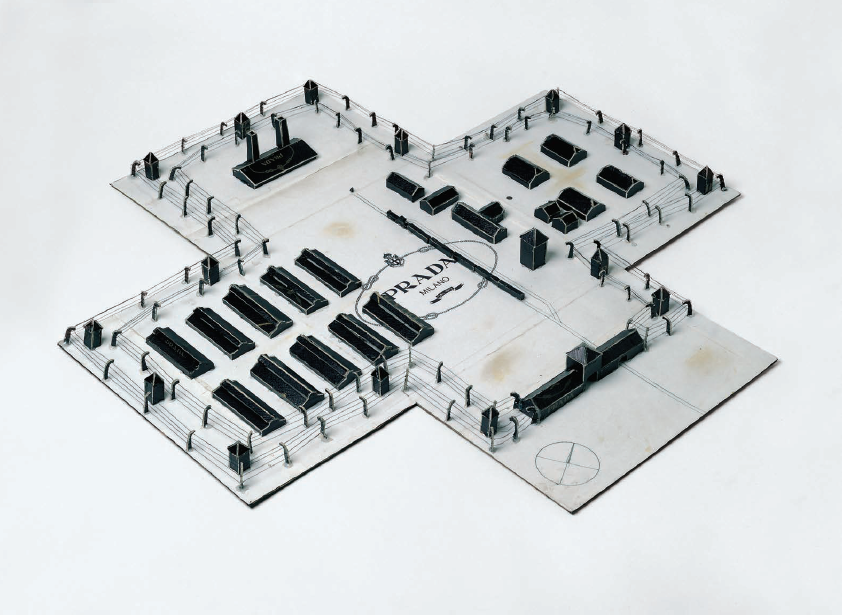
Prada Deathcamp, 1998. Cardboard, ink, and adhesive, 27.25 x 27.25 x 2 inches. Courtesy of the artist.
Yeah, totally.
And if I’m going to pick a couple of artists to really be my parents, it’s them. The best hip-hop was (and you could argue still is), like It Takes a Nation of Millions to Hold Us Back or Fear of a Black Planet, happened right before the laws were written to prevent art like that from happening without crediting, or to make it economically impossible to make—they were using a lot of the same strategies that Robert Rauschenberg’s Combines or collage paintings, where he had images from popular culture where you take found things that you know and recognize like a picture of a moon landing or a goat and a tire. We all know what a goat is, we all know what a tire is, but you combine them in this really wrong way and you get a magical combination. And when you use a car alarm as a percussive element, an annoying, beeping, horrible thing that we all have to endure, but you loop it—and looping is still one of the foundations, and still an underused thing in hip-hop—looping sounds is how you create a texture and a feeling, because music is rhythm. In a sculpture, I’ll have a graphic element or a formal element or a shape from one thing combined with a shape from another thing—something from 18th and 19th century ceramics or like coopering (making a bucket) combined with a 20th century weight-saving device for aerospace technology, and those two technologies are never connected, but you put them together and you get to tell a story of the bucket, of water conveyance. But also of abstract form and pure composition.
You’re describing a water bucket that’s used in Tea Ceremony—there’s one here in your studio.
And then you get a combination of coopering, which is those vertical slits, but then, of course, it’s a super high-tech epoxy resin, there’s nothing more advanced than a composite, which is epoxy, a hardener, and then a substrate of fiberglass as rebar (reinforcing bar) to keep the resin together. Because without internal structure it will crack, and then aluminum weight-saving struts with structural lightening holes and a wood handle that’s the exact milling profile of a lacrosse stick, which is an octagon, which is engineered to fit the hand.
Perfectly grippable.
Like the iPhone 5 that has a faceted edge instead of a perfectly round broomstick, which doesn’t grip as well, because it doesn’t grip into the crevices and digits of your hand meat. Whenever I make a handle for anything, one of the tricks I’ve learned is to squeeze it as hard as I can for as long as I can, like whatever—ten seconds or half a minute and then release. And then I feel where my hand hurts, and then I just file those parts down. Repeat till the pain is evenly distributed.
I thought you were going to say that when you grip it as hard as you can then you would look for the indentations and if it doesn’t make any indentations then that’s a problem because that means that you have no grippability.
Right, but because it’s a grip thing, I go by feel. And because when we buy a product like an iPhone 5 versus a 6, it’s ultimately the feel. That’s the difference between an Evian bottle and a Volvic bottle and a Poland Spring bottle. Some of them have little grips. Or the ridge of a coffee cup. Sure, it’s how it performs, like conveying water from the earth to your body, but it’s also how it feels, and how it makes you feel. It’s a very subtle thing.
Anything will work—your hand is a cup—you can pour water into it and drink it, but because it’s one of these things that have defined all cultures—you can judge any culture by its cups, or its weapons—it’s an opportunity to understand external cultural phenomenon. These plastic bottles are our cups; this is our cup that we throw out billions of every day. Right now we have water on tap that’s purified against bacteria and disease, yet we’re drinking water from a bottle made in France out of convenience and to support our complex tastes.
I want to get back to the bucket for a second, which is a water-carrying device. What is best about the bucket? Is it the combination of unlike materials? Is it the combination of different making traditions—the coopering and aerospace lightening? Is it that you’ve innovated, that you’ve made a better bucket by combining elements of some others? It has a straight side so it doesn’t bang against your leg when you carry it heavy and full of water; it just slips right by your leg . . . and by the way, the resin work there is very helpful, because it makes it nice and slippy so it just, you know, beautifully skims your leg. You make it sound simple. You described it beautifully in a detailed and complicated way, but of all of the things that go into making a Sachs bucket, what—I guess I’m just going to call them innovations—in all of the things that you’ve done, what do you value the most?
First is the utility, how it works, that it doesn’t bump against your leg, that it feels good in your hand, the handle is not so small that it digs into your hand, not so big that you can’t get a good grip on it—that it actually conveys water without leaking, although I have very low standards of performance excellence. My standards are not that it works every time no matter what, like in the military—but that it works at all. And then of course there’s the storytelling of all these different technologies through history and the old, new, from here and there, from aesthetics of military to colonial architecture—because coopering is a thing that you could argue was elevated in the New World. Lastly it’s always the look, which is generated by the maker’s politics.
It’s Shakery.
Yeah, there’s a spirituality of craft that the Shakers led. But none of that means anything if it doesn’t look good because you could do that bucket and paint it a hideous purple that was designed to appeal to the most number of consumers, that’s why that Apple teal—if you remember, teal was the first color, which was disgusting, and then they came out quickly with an equally ugly orange version, an equally ugly pink version.
Which were ripped right off of a popsicle box—those garish jewel-tone popsicles that we all loved.
But I suspect that it’s even worse, that it was a color council choice, and someone paid someone a lot of money to choose them, because it was only the generation after that that they did the last CRT iMac all white, and that was the much more powerful computer. That was the moment when Apple invented the color white. Before the iMac everything was beige.
Apple II plastic was some of the shittiest plastic in the history of the world.
I call that tan color “office.” I always wanted to paint one of the teal Apple iMacs that “office” color. I’m sure someone online has done that.
It doesn’t age the way the plastic does though, because that plastic started going yellow from the first millisecond.
Beautiful in a way. There’s an article someone sent me about the most hated Pantone color in Europe, and it’s basically army green.
Why is that?
I read they think it looks like smoker’s teeth. The context of that is that there’s nothing worse, but it’s basically army green. And you don’t see a lot of consumer products in army green. You don’t see any.
So that’s why you wanted to make the tea ceremony manual army green. You like army green.
Well I do, because the most beautiful things that are made without planned obsolescence, that are designed and built to never fail are army green, like all the best vehicles. If it had leather seats and a good surround sound system, I’d drive a Humvee or a Jeep, but not a Mercedes Geländewagen where they actually did all that and then painted it glossy black . . . like why can’t it be both? But, to get to the final thing, which in the end it has to look good. The bucket or the sculpture has to look good, and that’s a very subjective thing, and it boils down to taste. And my taste is the best taste that there is. I believe that everyone needs to say that about their own taste. Because I’m the artist, these sculptures are mine, and I know best for me.
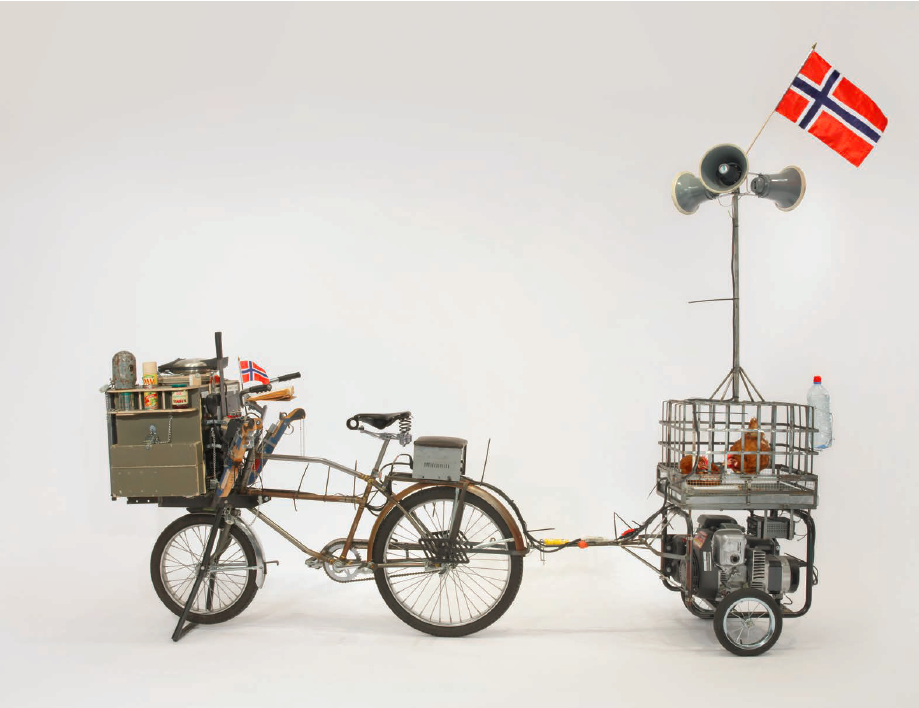
Waffle Bike, 2006. Mixed media, 105 x 125 x 29.5 inches. Courtesy of the artist.
Vision beats the shit out of data every time.
Always. Because it’s instinct. You don’t always know why, but if you feel why, and you’re sensitive to it, and intelligent, you can achieve great things. Now, of course, you can make the biggest blunders ever in the same way, but it’s better to have great failures and great successes than toe the line. Any day.
There’s one other subject that we should definitely talk about. We haven’t actually mentioned your show at YBCA. We barely mentioned the Noguchi show. I think you listed all the things that we should talk about at the beginning and I don’t think we’ve actually talked about any of them, and my final question for you has absolutely nothing to do with either one of them in a way, but it’s just because it’s definitely the elephant in the room. We’ve talked about it a lot, and it is such a good subject because you are brave in the way that you go right at things, so just to talk for a second about cultural appropriation and what that means. That’s really not the right term for what you do, but it’s easy to stereotype what you do as culture appropriation, so just to begin with, kind of a strong statement: You are not to Japan, in the context of tea ceremony, what the surrealists were to Africa. There is a huge element of imperialism and colonialism that’s missing from what you do. You are involving yourself in something, not stealing. You are trying to, if anything, when that is an issue, you’re trying to undo it, take it apart, re-engineer it, roll it back, fix it. You know, there’s so much heart and spirit in the way that you dive into other cultures, and cultures defined really, really diversely, from Satanism, Star Trek, Star Wars and the American arms manufacturing industry, to Japanese consumer electronics and tea ceremonies, and Barbie or whatever else. How do you look at it?
I love the tea ceremony because it’s a beautiful ritual activity. It’s also incredibly elitist. You have to be wealthy to do it. It’s insulting and unfair, but they go hand in hand. In Avant-Garde and Kitsch, Clement Greenberg talks about pulp fiction and how in the 20th century literacy became so much wider because with industrial culture you need workers who know how to read, but since they’re working in the factory all day they don’t have time to read really heavy stuff so they have to invent easier stuff, so pulp was invented so that more people can read it with less available leisure time. You have to have a lot of leisure time to read Proust and get through it, and when I see someone reading Proust I am in a way insulted that they’re not working harder to save puppies and help the planet. I say: how dare you!
Well, we all want it all.
There’s sort of an elitism in that much free time . . . it hurts. But at the same time I have tremendous respect for the tea ceremony. You could maybe look at it as cultural appropriation. But because no one is being exploited, it’s not appropriation; it’s amplification. We’re taking these ideas and blowing them up through a filter; the artist is the medium. I’m the filter and my experience as an American growing up in New York is a way of taking the Japanese tea ceremony through the filter of my experience and bringing it out the other end so it becomes an authentic representation of the tradition, but also an authentic expression of the studio. Through doing that it has the unique vision of the studio and it’s authentic. That’s very different from the sort of dogmatic misinterpretations of Sen no Rikyū’s teachings that were all about Mitate, using the wrong thing for the right reason, improvisation, the ready-made, all those things are thrown out the window because the tradition of the tea ceremony is so by the rules.
That wasn’t his fault. There’s nothing wrong with dogmatism in the first iteration.
It’s when it gets repeated and mutated—
The first iteration is genius. It’s just when it gets repeated that it becomes horse shit.
Right, and that amazing episode of Star Trek, I’m going to find it and send it to you, the Kohms and the Yangs, kind of is like that, when they mutated over generations and it got all crazy and weird, and Shatner doing the Declaration of the Independence—“We the people?” He reads the Declaration of Independence from memory to save the planet. It’s fantastic.
Does that fix it?
Oh yeah.
That does it.
Because he remembers it, because he’s Kirk. And he’s Shatner.
That is very Kirk. Kirk was very big on relics. So was Picard, right? Like owning special little bits from—amazing expressions of humanity.
Well because without art, none of this stuff is worth fighting for. That’s the good stuff, and throughout history all the great military guys and explorers love art. When Shackleton’s ship was crushed in the ice and they had to walk a thousand miles across ice, he delivers his speech to the survivors about traveling light and fast. He takes his gold pocket watch and throws it on the ice and his gold coins, and the Bible that the queen gave him, and tears out just the front page plus the book of Job, and he makes the photographer burn all his negatives so he doesn’t go back for them, and then he points and says, “but bring the guitar—we’ll need that.” That’s making art a priority.
I just want to talk about respect for a second because you say you have great respect for the tea ceremony, which sounds like a political statement, like it was written by your speech writer. It’s what respect means to you. What it means in this context is that you’ve devoted four years of your life to building an entire tea culture. That’s respect. You respect it enough to hate it in some of its particulars; you respect it enough to be bored to death by it. You respect it enough to insult it. What you do is you respect all of these cultures that you “appropriate” or borrow from or whatever through engagement. You respect them enough to dive into them and really live them, and try to make them live in the present—to make them genuine and present, and to open up new possibilities for them, for their future survival.
For me respect means a lot of things. Disrespect is part of respect.
Is any of what I said true or fair?
Absolutely. It sounds better than I imagine it. Yeah.
Time is respect.
Yeah, I want you to feel connected with me and with the experience, and not be alienated. And of course, one of the biggest problems with tea ceremony is that it takes eight years to be a good guest.
Which is a little alienating.
Which is totally classist and alienating, and my guests do not have eight years. I have served people with eight years experience. And it’s just as hard as serving someone with no experience, because they have eight years of expectation about the way it’s supposed to be. It’s a dance, and it’s sort of like doing martial arts with a black belt as a novice. Maybe I’m not a novice; maybe I’m a green belt or something. But in another way, to quote James Brown, “I don’t know karate, but I know crazy.” I’ve got my own form of martial arts, which is derived from serious study, and gets the job done. But again—respect is the most important thing because it’s kind of like filmmaking. If you don’t respect the viewer you lose the most valuable thing, which is their attention.
You’re learning. You’re teaching yourself things.
Yeah, yeah. I have some of the parts left over and worked into other things. That’s the most important, keeping attention, and it’s performance, and it’s time. But also that’s why I focus so much on the tea ceremony and about the objects, because it’s very difficult, the performance stuff, and time is very frustrating, and I hate it. I’m so fucking sick of these tea ceremonies. It’s so not fun. It’s like throwing a dinner party for someone who doesn’t love you, who doesn’t want to be there. And that’s also why it’s so rewarding when someone is into it, when I see the light in someone’s eye and they’re excited about something. It’s very rewarding to feed someone. But one more thing—because Johnny just asked me—why the tea ceremony? You said once, why the tea ceremony and the space program, what do they have to do with each other? Which is a question that you’ve been asking from the beginning, about YBCA, and I would answer: astronauts and rocket scientists at the other NASA work hard to scrub the spaceship so that they don’t have bacteria on them, so that we don’t bring earth creatures to Mars. So we don’t pollute Mars. But as an American, and as a member of the creative community during the Homogenocene, the time when we bring bacteria all around the world and trade in goods that destroy and build economies and even change the geologic landscape, global warming, all these things that humans do—but whatever, I’m going to bring the noise. I’m not going to scrub the spaceship of bacteria, so I’m going to bring bacteria to Mars, accidentally or on purpose. If we don’t find life on Mars we’ll put it there.
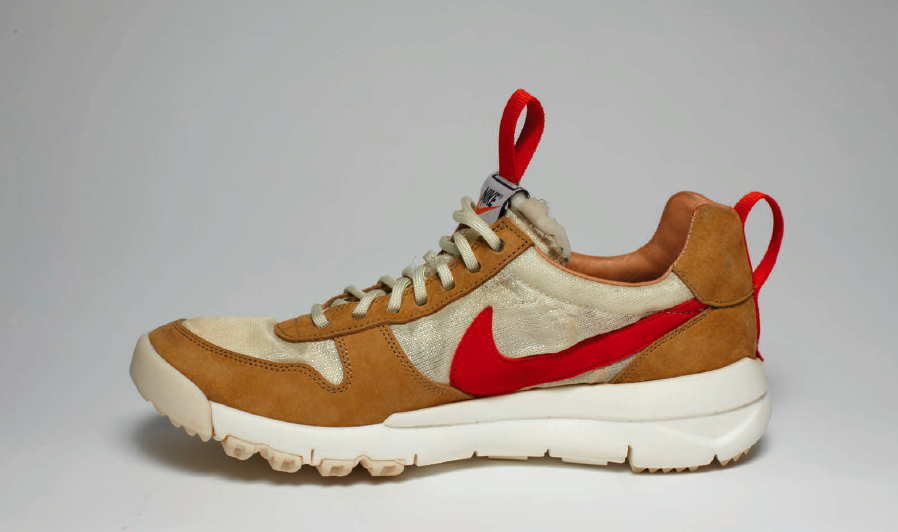
NIKE Mars Yard Shoe, 2011. Courtesy of the artist.
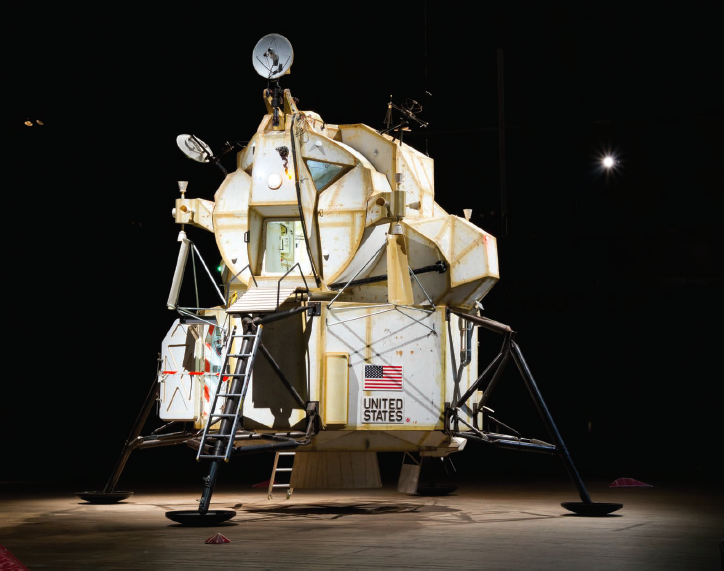
Landing Excursion Module (LEM), 2007. Steel, plywood, resin, electronics, and assorted found objects, 277 x 263 x 263 inches. Courtesy of the artist.
You’ve done that. You seeded Mars, the Martian surface, with poppy seeds.
But that’s the opposite, it’s called terraforming, and it’s a controversial thing that some people like Elon Musk think is essential to our survival, and other people in NASA Planetary Protection Protocol think is unethical. But that’s a debate. The key issue of our culture is the African diaspora. How Africans were taken—abducted—and brought to the New World to build an industrial power big enough and power enough to defeat the Nazis and eventually go to the moon. This wonderful thing happened at a horrible cost to humanity. The byproduct of slavery was the greatest art of the 20th century, and that’s the art of Louis Armstrong, and the boombox is a symbol of that because it’s the symbol of street culture and Lil Wayne, his greatest disciple. But, if I’m going to pick an object that exists, or an art object, or an art form that exists in purity, I’m going to go back a little farther. I’m going to go back to 16th century Japan, which is an adaptation of Chinese tea ceremony. The Japanese have always taken things from other cultures. They’ve taken the Chinese tea ceremony and elevated it, they hijacked Korean pottery, they out-Leica’d Leica, they out-denimed Levi’s. The 16th century Japanese tea ceremony—which has remained largely unchanged for the past 500 years, represents the best of what humanity can offer in a pure form, a pure dogmatic, ridiculous, precise manner with its appreciation of nature, of religion or philosophy through Zen, the adaptation of Chinese scrolls, of ceramics, of the sensuality of food, of the architecture of the kimono, poetry, haiku, ceramics, these are all descendants of that, so that’s why, in a way it’s my version of Carl Sagan’s gold record that’s bolted to the front of Voyager. To me it’s the bridge to the space program.
Yeah, I guess what I connect to in it is that NASA—it’s so wonderful, powerful, that there is this agency (and it’s hilarious and so paradoxical that it’s a US government agency) that represents more than anything else does, humanity. And humanity at its best, at its most aspirational. I love that—what you say is that—in trying to work through getting the most out of your astronauts and your ground crew, which is part of your job, running your NASA, the best strategies are exercise and tea ceremony. Those are the most effective tools for keeping people at a peak level of performance, for managing the kinds of problems that you have to manage when you’re in a little tin can with one other person traveling for nine months to get to Mars in a super hostile environment. It’s the tea ceremony that for you represents the apex of communal human coping culture. Not that it’s perfect in any way or anything like that, but that it’s got lots of components, in the ritual and the tools and everything about it, the whole culture of it, that is us being as good as we can be in a kind of quiet, simple, fully integrated, connected to our environment kind of way. It’s lovely.
That’s beautiful. I appreciate hearing that because I think it would easy to look at this as an overabundance of bureaucratic nonsense. Whether it’s the space program and all the systems and keeping people alive in a hostile environment, or preparing an elaborate and obsessive tea ceremony—but all those ritual steps themselves are the art.
It’s also the survival of it because you’re saying that’s what keeps us alive, that’s what makes NASA work, all of their to-do lists. That’s what makes the studio work, it’s all the to-do lists. Tea ceremony is training for that approach to things, that systematic, quiet approach. I’m still not able to make a bowl of tea the right way, which is doing only one thing at a time. I cannot make myself do one thing at a time.
Neither can I. People ask how many proper tea ceremonies have you been to? Zero!
Zero! All the training, preparation, everything else, still—zero. One final thing about Tea Ceremony at Noguchi, and I mean the actual ceremony. I want to ask you about a magical moment. I always like things that are surprising—we all do—we like to be surprised. Your version of a tea ceremony has a shot clock, and we make jokes about it and why it’s important, and the whole idea that Americans don’t have much patience for the time that self-enlightenment takes, so you’ve put it on the clock. Like, hey, self knowledge is on notice. We have to do it pretty quickly—get centered, find ourselves—or it doesn’t seem worth doing. But you always manage to take something that seems like a joke and make it into something sacred. This is an example of that. That high school basketball buzzer ends up being the perfect unexpected thing, the magical thing that transforms the experience. In some ways it’s the most important part of your version of tea ceremony. Like music, it speaks straight to the brain. It’s not formal, it’s not physical, it’s not seen, it’s just heard. It sounds through beautiful little handmade ceramic bells, or domes, that you made for this unit. But that sound, plus the special environment, the tea house in the indoor-outdoor galleries at Noguchi, in the context of that ritual, takes it to Europa, takes it to outer space, takes it somewhere so perfectly idiomatically American. Every time I hear it, it fucks with my brain. It’s like part of my brain is imagining it as the intonation of a gong or a bell in a Zen temple.
It’s a wake-up call. It’s an alarm saying “foul” or “end of period.”
Or be here now!
Exactly.
It’s crazy! It’s so perfectly hybrid. Just that one obnoxious sound.
It’s a re-centering sound. When it says “Be here now,” it’s a wake-up call. A slap in the face. The most shocking thing possible, but it does snap you out of it and it helps you to be centered.
That sound, that centering—centering is such a great metaphor and it connects for me to the density of a nugget. I would say one thing that a nugget is—a nugget is like a black hole or a sun—it’s a super-dense thing in the universe which creates a gravitational field that pulls other things in. And the amazing thing about that sound—which is so simple, such a throw away in a way: a two-cent ringtone you downloaded for nothing is that in that context it gets the whole universe of tea swirling around it in a new and different way that’s unbelievably transporting. Just like tea is supposed to be. Thank you for that.
Thanks, Dakin.
